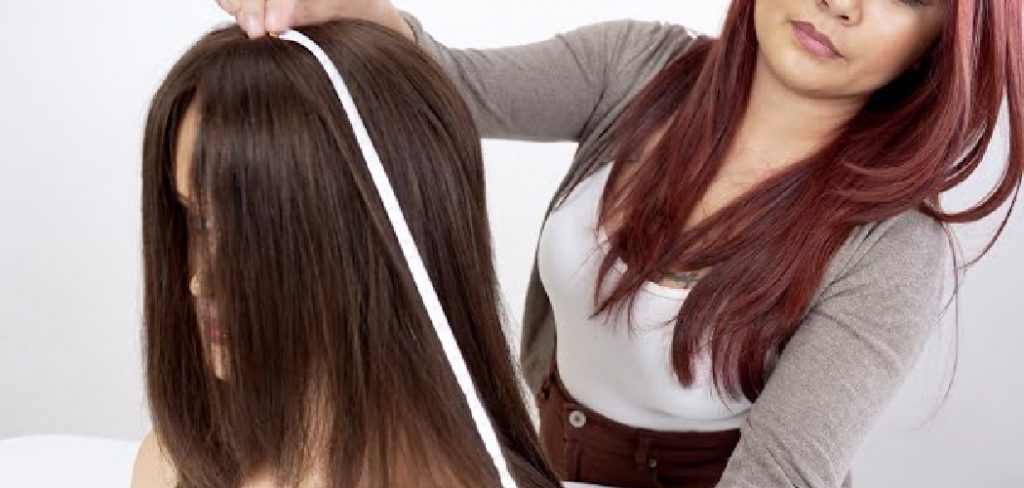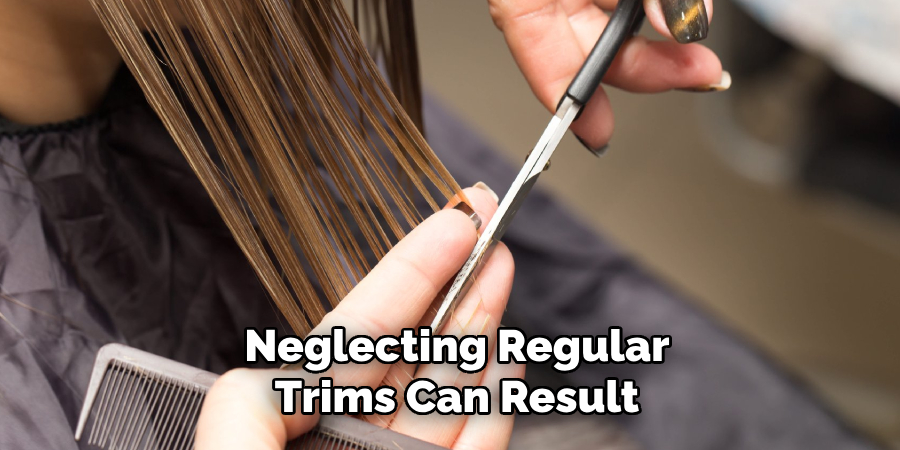Are you planning on getting a haircut or trying a new hairstyle but need help communicating the desired hair length to your stylist? If so, you’re not alone. Many people need help with accurately measuring their hair length, especially regarding unconventional hairstyles or terms.

How to measure hair length is essential when it comes to hairstyling, choosing hair extensions, or simply keeping track of your hair growth progress. Whether you want to achieve a specific hairstyle or determine the effectiveness of your hair care routine, knowing how to measure your hair length accurately is key.
In this guide, we’ll walk you through the step-by-step process of measuring your hair length, providing you with the knowledge and tools to confidently assess and track your hair’s growth and styling goals.
Why Measure Hair Length?
Before we dive into the actual measuring techniques, it’s crucial to understand why measuring your hair length is essential. Here are a few reasons why knowing your hair length can benefit you:
- Accurate Communication with Your Stylist: We’ve all been there – trying to describe a specific haircut or style to our stylist and ending up with something completely different. Knowing how to measure your hair length lets you communicate precisely what you want, minimizing the risk of miscommunication.
- Tracking Hair Growth Progress: Whether you’re on a hair growth journey or simply curious about how fast your hair grows, regularly measuring your hair length can help track its progress.
- Choosing the Right Hair Extensions: Hair extensions come in various lengths, and determining your hair length can help you select the perfect match for a seamless and natural-looking result.
- Monitoring the Effectiveness of Your Hair Care Routine: Regularly measuring your hair length can help you see how well your current hair care routine is working. If you need to get the desired results, it might be time to switch things up.
Now that we’ve established why measuring hair length is essential, let’s examine the different ways to do so accurately.
What Will You Need?
Before you start measuring your hair, make sure you have the following tools on hand:
- A ruler or tape measure
- Hair elastics or clips
- A mirror
- A comb
Once you have these items ready, follow the steps below to determine your hair length correctly.

10 Easy Steps on How to Measure Hair Length
Step 1. Start with Clean, Detangled Hair:
Before measuring your hair length, it’s essential to ensure that it is clean and free from tangles or knots. This will help you get a more accurate measurement without interference from product buildup or tangled strands.
Start by washing and conditioning your hair using your regular hair care products, and gently comb through your hair to remove any knots or tangles. Once your hair is clean and detangled, you’re ready to proceed with measuring your hair length accurately.
Step 2. Use a Straightening Iron or Blow Dryer:
If you have curly or wavy hair and want to measure its true length, it’s recommended that you straighten it using a straightening iron or blow dryer.
This will help you get a more accurate measurement, as curly or wavy hair tends to appear shorter when not straightened. However, remember that this step is optional and can be skipped if you prefer to measure your hair in its natural state.
Step 3. Divide Your Hair into Sections:
To ensure precision, divide your hair into smaller, manageable sections, particularly if you have thick or long hair. Use hair elastics or clips to separate your hair into four main sections—two at the front and two at the back. This step helps isolate each section for more accurate measurement and prevents overlapping strands from causing errors.
Step 4. Choose a Section to Start With:
Begin with one section of your hair, preferably at the back. Use a mirror to get a clear view of this section if necessary. Comb through it gently to ensure it’s free of tangles or uneven strands. If you’re naturally working with curly or textured hair, stretch the section to measure its entire length.

Step 5. Position the Measuring Tool:
Once you have prepared your hair and chosen a section, it’s time to select a measuring tool. A flexible measuring tape or ruler is ideal for accurate measurements. Hold the measuring tool at the base of the section and extend it down to the end of the hair, ensuring it follows the natural curve of your strands.
Keep the measuring tool straight and parallel to the floor for consistent and precise measurements. Take note of the measurement in inches or centimeters and repeat the process for each section of your hair. Remember to record the measurements carefully for future reference or comparison.
By positioning the measuring tool properly and maintaining consistency throughout the process, you will obtain accurate measurements of your hair length, which will provide valuable information for styling, trimming, or monitoring your hair growth progress.
Step 6. Repeat for Each Section:
Once you have measured the length of one section of your hair, continue the process for each remaining section. This is important because hair length can vary between sections due to layering or uneven growth. By measuring each section individually, you will have a comprehensive understanding of the overall length and any variations throughout your hair.
Remember to maintain consistency in position and use the measuring tool for each section to ensure accurate and reliable measurements. Measuring each section will provide precise information about your hair length and allow you to make informed decisions regarding styling, trimming, or tracking your hair growth progress.
Step 7. Calculate the Average Length:
Once you have measured each section of your hair, you can calculate the average length by adding all the individual measurements and dividing them by the number of sections you measured.

For example, if your front sections measure 12 inches and 15 inches, and your back sections measure 18 inches and 21 inches, respectively, the average length of your hair would be (12+15+18+21)/4 = 16.5 inches.
Step 8. Measure Your Hair from Root to Tip:
If you want to know your entire hair length from root to tip, measure where your hairline meets your forehead down to the ends of your hair. This will give you an overall hair length measurement and help you determine the appropriate size for any extensions or hairpieces. Be careful not to measure too tightly or loosely, as this can affect the accuracy of your measurement.
Step 9. Consider Your Desired Hairstyle:
When choosing hair extensions, consider the hairstyle you want to achieve and how much extra length is needed. If you want a dramatic transformation, opt for longer extensions that are closer to your full hair length measurement.
If you prefer a more natural look, choose shorter extensions that blend seamlessly with your current length. Try to match the texture and color of your extensions to your natural hair for a more cohesive look.
Step 10: Monitor Your Hair Growth Progress:
Measuring your hair regularly is crucial for tracking its growth progress and evaluating the effectiveness of your current hair care routine. By keeping track of your hair length, you can see how quickly your hair is growing and make any necessary adjustments to enhance its health and appearance.
Regularly measuring your hair length can also help you detect any potential issues, such as excessive shedding or breakage, that may need to be addressed.
By following these steps, you can accurately measure your hair length at home and use the information to achieve your desired hairstyle or track your hair growth journey.
5 Things You Should Avoid
- Using Different Measuring Techniques: Avoid using different techniques each time you measure your hair length, as consistent methods can lead to accurate results. Stick to one measuring technique to ensure consistency and reliable tracking of your hair growth progress.
- Measuring Wet Hair: Measuring your hair length when it’s wet can result in stretched strands, giving a false impression of longer hair. It’s best to measure your hair when it’s dry and natural to get an accurate measurement.
- Not Pulling the Hair Taut: Failing to pull your hair taut while measuring can lead to uneven or inaccurate measurements. Make sure to gently pull your hair straight and firmly hold the measuring tape against your scalp to get precise measurements.
- Ignoring Hair Shrinkage: If you have curly or textured hair, remember that it may shrink when dry. Avoid measuring your hair when shrunken, as it may not reflect its true length. Instead, measure when your hair is stretched or straightened for more accurate results.
- Neglecting Regular Trimming: Neglecting regular trims can result in split ends and breakage, affecting your hair’s overall appearance and length. To accurately measure your hair length, maintain a consistent trimming routine to keep your ends healthy and prevent uneven length measurements.
By avoiding these common pitfalls, you can ensure accurate and reliable measurements of your hair length, allowing you to track your progress and make informed decisions about your hair care routine.

Conclusion
How to measure hair length is a simple yet essential process that can provide valuable information for maintaining healthy and stylish hair.
By following these steps and avoiding common mistakes, you can accurately measure your hair length at home and use the information to achieve your desired hairstyle or track your hair growth progress.
Remember to always be consistent in measuring and recording your lengths. This will help you obtain precise measurements every time. Happy measuring!
About the Author
Jane Hubbard is a passionate beauty expert with a wealth of experience in makeup, hair, and overall beauty techniques. After years of working as a hairdresser specialist, she followed her entrepreneurial spirit and started her own consultancy business.
Jane has always been driven by her desire to help others feel confident in their own skin, and she does this by sharing her knowledge, experiences, and practical beauty tips. Through her consultancy, she empowers individuals to embrace their unique beauty, offering tailored guidance that boosts both self-esteem and personal style.
Professional Focus
- Specializes in makeup, hairstyling, and beauty consulting.
- Provides personalized beauty advice, tips, and techniques to help individuals feel confident in their appearance.
- Dedicated to staying up-to-date with the latest industry trends and developments.
- Passionate about creating a comfortable and empowering experience for every client.
Education History
- University of Craft and Design – Bachelor of Fine Arts (BFA) in Woodworking and Furniture Design
- Woodworking Apprenticeships – Extensive hands-on training with skilled craftsmen to refine carpentry and furniture making techniques
- Online Courses & Masterclasses – Continued education in advanced woodworking techniques, design principles, and specialized tools
Expertise:
- Makeup artistry, hairstyling, and beauty consulting.
- Personalized beauty techniques to enhance confidence and self-expression.
- Educating clients on how to maintain their beauty routines at home.
